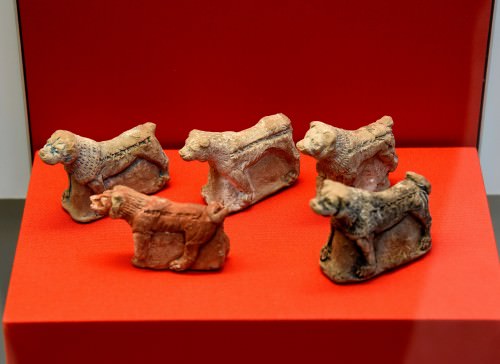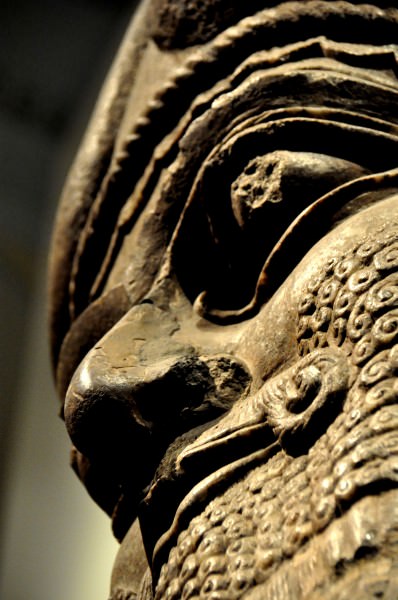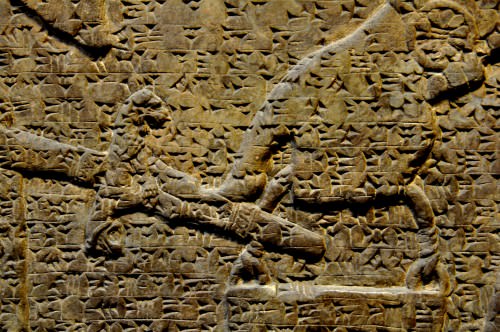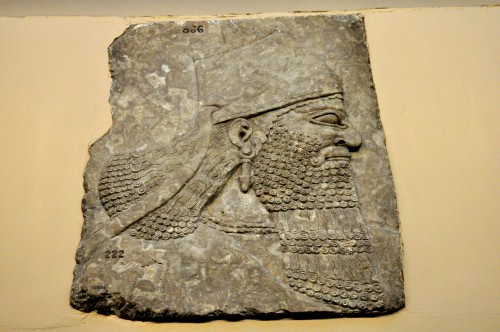Gula › The Greatest Party Ever Thrown: Ashurnasirpal II's Kalhu Festival » Origins and History
Gula › The Greatest Party Ever Thrown: Ashurnasirpal II's Kalhu Festival » Origins and History








with permission from the Website Ancient History Encyclopedia
Content is available under License Creative Commons: Attribution-NonCommercial-ShareAlike 3.0 Unported. CC-BY-NC-SA License
Articles and Definitions › Contents
- Gula › Ancient History
- The Greatest Party Ever Thrown: Ashurnasirpal II's Kalhu Festival › Antique Origins
Ancient civilizations › Historical places, and their characters
Gula › Ancient History
Definition and Origins

Gula (also known as Ninkarrak) is the Babylonian goddess of healing and patroness of doctors, healing arts, and medical practices. She is first attested to in the Ur III Period (2047-1750 BCE). Her name (Gula) means 'Great' and is usually interpreted to mean 'great in healing' while Ninkarrak means 'Lady of Kar,' interpreted as 'Lady of the Wall,' as in a protective barrier, though it has also been taken to mean 'Lady of Karrak,' a city associated with that of Isin. In Sumeria, she was referred to as 'great physician of the black-headed ones' (the Sumerians ). She is commonly referred to in Mesopotamian medical texts and incantations as belet balati, 'Lady of Health,' and as Azugallatu, 'Great Healer.' Her main cult center was at Isin, though her worship would spread across Sumer in the south upwards to Akkad and, eventually, throughout the entire region of Mesopotamia. Her iconography depicts her always with a dog, sometimes seated, and surrounded by stars. She is associated with the underworld and transformation.
Originally Gula was a Sumerian deity known as Bau (or Baba), goddess of dogs. People noticed that when dogs licked their sores, they seemed to heal faster, and so dogs became associated with healing and Bau transformed into a healing deity.When her worship spread from the city of Lagash to Isin, she became known as Ninisina ('Lady of Isin'). Her other names included Nintinugga and Nimdindug, which related to her healing talents, or still others which simply elevated her to patroness of a city. Scholar Jeremy Black notes that many of her names were "originally the names of other goddesses [such as Meme]" whom she assimilated (101). When she was venerated in Nippur, she was known as Ninnibru, 'Queen of Nippur,' and associated with the hero-god Ninurta. She became known as Gula, the great healer, during the latter part of the Old Babylonian Period (2000-1600 BCE) and is best known by this name in the present day.
MYTHOLOGICAL ORIGIN & FAMILY
She was the daughter of the great god Anu, created with his other children at the beginning of time, and her husbands/consorts are variously given as Ninurta, the healer god, and divine judge Pabilsag, or the agricultural god Abu.Scholar Stephen Bertman writes, "Because at least two of these divinities were connected with agriculture, her marriage to them may symbolically reflect the medicinal use of plants" (119). Her sons were Damu and Ninazu, and her daughter Gunurra, all healing deities.
ORIGINALLY GULA WAS A SUMERIAN DEITY KNOWN AS BAU, GODDESS OF DOGS. AS DOGS BECAME ASSOCIATED WITH HEALING, BAU TRANSFORMED INTO A HEALING DEITY.
Damu was the central Sumerian god of healing who combined the magical and 'scientific' approaches to disease. He was associated with the dying and reviving god figure Tammuz (also known as Dumuzi) central to the tales involving Inanna and rebirth; hence he is also associated with transformation and transition. He is frequently mentioned with Gula in incantations for healing. Although Gula was considered the supreme healer, Damu was thought to be the intermediary through which her power reached doctors.
Ninazu, who was associated with serpents (symbols of transformation), the underworld (transition), and healing (transformation), carried a staff intertwined with serpents. This symbol was adopted by the Egyptians for Heka, their god of magic and medicine, and then by the Greeks as the caduceus, the staff carried by Hermes Trismegistus, their god of magic, healing, and writing (associated with the Egyptian god Thoth ). Today, of course, the caduceus is seen in doctor's offices and medical practices around the world as the symbol of Hippocrates, the father of medicine.
DOCTORS IN MESOPOTAMIA
There were two types of doctors in ancient Mesopotamia: the Asu (a medical doctor who treated illness 'scientifically') and the Asipu (a healer who relied upon what modern people would call 'magic'). There were also surgeons and veterinarians who could come from either of these backgrounds. Dentistry was practiced by both kinds of doctors and both may have also presided at births. It is certain that midwives ( sabsutu ) delivered the child, not the doctor, and yet the doctor was paid a fee for providing some kind of service at births, since records make it clear that they were paid more for the birth of a male child than a female. It is possible that the Asipu could have recited prayers to the gods or chants to ward off demons (most notably the demon Lamashtu who killed or carried off infants) or that the Asu could have eased labor pains with herbs but not assisted with the actual birth.

A Mesopotamian Tablet with Gynaecological Recipe Against Miscarriage
A pregnant woman and one who was in labor wore special amulets to protect her unborn child from Lamashtu and to invoke the protection of another demon called Pazuzu ('demon' did not always carry the connotation of evil that it does in the modern day and could be a benevolent spirit). Although modern-day scholarship sometimes refers to the Asipu as a 'witch doctor' and the Asu as a 'medical practitioner,' the Mesopotamians regarded the two with equal respect. Scholar Robert D. Biggs notes:
There is no hint in the ancient texts that one approach was more legitimate than the other. In fact, the two types of healers seem to have had equal legitimacy, to judge from such phrases as, 'if neither medicine nor magic brings about a cure,' which occur a number of times in the medical texts. (1)
The significant difference between the two types was that the Asipu relied more explicitly on the supernatural, while the Asudealt more directly with the physical symptoms the patient presented with. Both types of healers would have accepted a supernatural source for illness, however, and the Asu should not be considered more 'modern' or 'scientific' than the Asipu.
These doctors operated out of the temples and treated patients there but more frequently made house calls. The city of Isin, as cult center for Gula, is thought to have served as a training center for physicians, who were then sent to temples in various cities as needed. There is no evidence of private practice per se, although kings and the more affluent had their own physicians. The doctor was always associated with some temple complex.
Women and men could both be doctors, though, as scholar Jean Bottero notes, "Women scribes or copyists, exorcists or experts in deductive divination [the Asipu and Asu ] could be counted on the fingers of one hand" (117). Still, there were more female physicians in Sumer than elsewhere, and it was no accident that it was the Sumerians, with their high regard for women, who first envisioned a female deity of healing.
ILLNESS & THE GODS
Illness and disease were thought to come from the gods as a punishment or a wake-up call to the individual. The gods had created human beings as their co-workers and so cared for them and provided for their happiness. Even so, as Bottero points out, humans had a tendency toward sin and sometimes needed correction in the form of illness or affliction to turn them back to the right path. Sickness might have other supernatural causes, however, such as demons, evil spirits, or the angry dead. It was entirely possible for an innocent to fall sick, through no fault of their own, and for the doctors to perform every incantation correctly and apply the proper medicines, and yet that person still die.

Doctor's Medical Recipe from Babylon
Even if one god intended only the best for the sick person, another god could have been offended and would refuse to be placated, no matter what offerings were made. To further complicate the situation, one also had to consider that it was not the gods causing the problem but, instead, a ghost whom the gods allowed to cause the trouble to rectify some wrong, or simply an evil spirit, demon, or an angry ghost. Biggs writes:
The dead – especially dead relatives – might also trouble the living, particularly if family obligations to supply offerings to the dead were neglected. Especially likely to return to trouble the living were ghosts of persons who died unnatural deaths or who were not properly buried - for example, death by drowning or death on a battlefield.(4)
Medical books from the library of Ashurbanipal make it clear, however, that doctors had an impressive amount of medical knowledge and applied this regularly in caring for their patients and appeasing the gods and the spirits of the dead. This knowledge, it was thought, came from Gula as a gift from the gods. In the same way that they had sent the affliction, for whatever reason, they also provided the means for a cure. Gula was frequently called upon for help in conception, especially when it was thought some supernatural entity was interfering, and appears in inscriptions invoking fertility. Whether the disease was caused by a god, ghost, or evil spirit, the healing powers of Gula could usually restore the patient to health. She was not always so kind and solicitous, however, and was just as well known for her violent temper.
GULA AS PUNISHER & PROTECTRESS
The goddess is almost as frequently invoked in curses as she is in healing. She was thought to be able to bring earthquakes and storms when she was angered, and among her epithets is 'Queen of the Tempest' and 'She Who Makes Heaven Tremble.'A tablet from the reign of Nebuchadnezzar I (1125-1104 BCE) invokes Gula as a protectress for a memorial. It was customary, whenever a king erected a monument, to add a curse to the inscription on anyone who would deface or remove it, calling upon the gods to punish the transgressor in all kinds of ways. The inscription on Nebuchadnezzar I's memorial reads in part how, if anyone should deface or remove it, "May Ninurta, the king of heaven and earth, and Gula, the bride of E-Sharra, destroy his landmark and blot out his seed" (Wallis Budge, 126). She is also mentioned in other inscriptions in the same way.

Terracotta Plaque Dedicated to Gula
People thought to appease her through worship at her temples where dogs roamed freely about and were well cared for as her sacred companions. Bertman writes, "Her sacred animal was the dog and ceramic models of dogs were dedicated to her at her sanctuaries by those who had been blessed by her tender mercies" (119). The famous Nimrud Dogs, ceramic statuettes found in the 1950's CE at the city of Nimrud, are among the best-known examples of amuletic figures dedicated to Gula.
Her healing powers were as greatly respected as her temper was feared, and her other epithets include 'Healer of the Land,' 'She Who Makes the Broken Whole Again' and 'The Lady Who Restores Life.' It was Gula, after the Great Flood, who breathed life into the new creatures created by the gods to animate them. Through this act, and her care for humans afterwards, she was considered a kind of Mother Goddess, along the same lines as Ninhursag who actually created the bodies of human beings.
Worship at Gula's temples, shrines, and sanctuaries would have been the same as that of any Mesopotamian god or goddess: the priests and priestesses of the temple complex would have taken care of her statue and inner sanctum, and the people would have paid their respects in the outer courtyards, where they would have met with the clergy, had their needs addressed, and left their gifts of supplication or thanks. There were no temple services such as one would recognize in the modern day.

Model Clay Dogs from Nineveh
One significant difference between rites at her temples and at those of other deities was the dogs who somehow took part in the healing rituals, though precise details of what they did are unclear. They may have played a part in ritual sacrifice as there were over thirty dogs buried beneath the ramp leading to Gula's temple at Isin. These dogs may have simply been temple dogs, however, who were honored with burial at the entrance. Ceramic figures like the Nimrud Dogs were buried at doorways and thresholds, often inscribed with Gula's name, for protection against harm. These figurines have been found at a number of sites besides Nimrud, most notably at Nineveh, and inscriptions make clear that burying dog figures - or in this case actual dogs - was a powerful charm in protecting a home from evil.
Female deities lost much of their prestige during the reign of Hammurabi (1792-1750 BCE) and afterwards when male gods dominated the theological landscape, but Gula continued to be worshiped in the same way and with the same respect. Her transformative powers associated her with agriculture (another of her epithets is 'Herb Grower'), and so she was worshiped in hopes of a good harvest, as well as for childbearing and good health in general. Veneration of the goddess continued well into the Christian period, and in the Near East, she was as popular as many better-known deities like Isis and Athena. Her cult declined as Christianity became more entrenched in the minds of the people until, by the end of the first millennium CE, she had been forgotten.
The Greatest Party Ever Thrown: Ashurnasirpal II's Kalhu Festival › Antique Origins
Ancient Civilizations
The kings of the Neo-Assyrian Empire have long been considered some of the most ruthless monarchs in ancient history.However, at the same time they were sacking cities and slaughtering those who rebelled against them or resisted conquest, they often pursued gentler interests. Sennacherib (reigned 705-681 BCE) enjoyed gardening and loved flowers. His son, Esarhaddon (reigned 681-669 BCE) was more interested in building projects than military conquest, even though he decimated Egypt. His son and successor Ashurbanipal (reigned 668-627 BCE) is better known for his library than for any of his military campaigns. This same pattern can be seen in earlier kings of the empire as well and is epitomized in an event which might be the greatest party ever thrown.

Head of Lamassu from Ashurnasirpal II palace
In the year 879 BCE, the Assyrian king Ashurnasirpal II (reigned 884-859 BCE) organized a festival to celebrate the completion of his new city, Kalhu, and the inauguration of his grand new palace. He invited the whole country to attend and 69, 574 people accepted, including the 16,000 new citizens of Kalhu and 5,000 dignitaries from his own territories and foreign lands. While scholars have suggested that the festival may have served the king as a public relations gesture, he certainly did not need to go to the trouble. By the time Kalhu was built and Ashurnasirpal II had moved into his grand palace, his reputation as a monarch not to be trifled with had been firmly established. This, after all, was the king who wrote of his conquest of the rebel city of Tela in c. 883 BCE:
I built a pillar over against the city gate and I flayed all the chiefs who had revolted and I covered the pillar with their skins. Some I impaled upon the pillar on stakes and others I bound to stakes round the pillar. I cut the limbs off the officers who had rebelled. Many captives I burned with fire and many I took as living captives. From some I cut off their noses, their ears, and their fingers, of many I put out their eyes. I made one pillar of the living and another of heads and I bound their heads to tree trunks round about the city. Their young men and maidens I consumed with fire. The rest of their warriors I consumed with thirst in the desert of the Euphrates.
Like King Tiglath Pileser I before him (reigned 1115-1076 BCE), Ashurnasirpal II did not care if people hated him, so long as they feared and obeyed him. A public relations event such as the Kalhu festival would have been considered unnecessary by a monarch who had already gone to great lengths to make sure his name was synonymous with terror. It could be, then, that Ashurnasirpal II threw his great party simply because he wanted to show off his new city and palace. Reasons for the actions of Assyrian kings are not often made clear in their inscriptions (unless they are justifying the sacking of cities) as historian Marc Van de Mieroop notes:
It seems safe to say that the building of new cities was a complex enterprise. If this conclusion is correct, we would expect the kings who undertook the work to elaborate on their activities in their building inscriptions. Yet, when we study these texts, we find a lack of information on certain aspects of the undertaking. First, the kings must have had a motivation for the building of these vast cities but, when we look at their records, no reason for the work is declared. Ashurnasirpal's justification for the work on Kalhu is merely a statement that the city built by his predecessor Shalmaneser had become dilapidated ( The Ancient Mesopotamian City, 55).
In the same way that the kings felt no need to justify the building of their cities, Ashurnasirpal II seems to have felt no need to elaborate on his reasons behind throwing his party. In his inscriptions he writes:
When I consecrated the palace of Kalhu, 47,074 men and women, who were invited from every part of my land, 5000 dignitaries and envoys of the people of the lands Suhu, Hindanu, Patinu, Hatti, Tyre, Sidon, Gurgumu, Malidu, Hubushku, Gilsanu, Kummu, And Musasiru, 16,000 people from Kalhu, and 1500 palace officials, all of them – altogether 69,574 including those summoned from all the lands and the people of Kalhu – for ten days I gave them food, I gave them drink, I had them bathed, I had them anointed. Thus I did honor to them and send them back to their lands in peace and joy.
The menu from the great feast has been preserved; his Banquet Stele records that this celebration included, but was not limited to, 1,000 oxen, 1,000 domestic cattle and sheep, 14,000 imported and fattened sheep, 1,000 lambs, 500 game birds, 500 gazelles, 10,000 fish, 10,000 eggs, 10,000 loaves of bread, 10,000 measures of beer, and 10,000 containers of wine (Bauer, 337). Ingredients, spices, and other edibles included sesame, grains, grapes, onions, garlic, honey, mustard, milk, nuts, cheese, olives, dates, ghee, and turnips. As Marc Van de Mieroop writes, “This was a special banquet, and worthy of boasting” (155). Scholars continue to speculate, however, on why the king would throw such an elaborate festival for the people when he did not have to do so.

Standard Inscription of king Ashurnasirpal II
There is no other reason given for the party than simply that the king felt like it. Kalhu had been an old trading center which had fallen into ruin over the years and was completely re-built by Ashurnasirpal II. His greatest pride was his new palace, and it seems a simple enough explanation that the king just wanted to show off what he had accomplished – off the battlefield – to as many admirers as he could gather. This does not mean, of course, that he did not wish to impress upon them his military victories. Although it is thought that few of the guests would have been invited into the palace, the dignitaries who are mentioned in the inscription may well have been. There they would have seen the massive reliefs lining the walls depicting the king slaying lions with his bare hands and toppling city walls and massacring those who opposed him. Along with the pictures, they would have read the king's words, repeated over and over on the reliefs, the so-called Standard Inscription. Historian Jonathan Taylor describes the inscription in this passage:
The Standard Inscription is, as its name suggests, a single, standardised text which recounts the victories of Ashurnasirpal. The first five lines assert the king's credentials:Palace of Ashurnasirpal, vice-regent of Ashur, chosen one of the gods Enlil and Ninurta, beloved of the gods Anu and Dagan, destructive weapon of the great gods, strong king, king of the universe, king of Assyria, son of Tukulti-Ninurta, great king, strong king, king of the universe, king of Assyria, son of Adad-nirari, great king, strong king, king of the universe, king of Assyria; valiant man who acts with the support of Ashur, his lord, and has no rival among the princes of the four quarters, marvellous shepherd, fearless in battle, unopposable mighty floodtide, king who subdues those insubordinate to him, he who rules all peoples, strong male who treads upon the necks of his foes, trampler of all enemies, he who smashes the forces of the rebellious, king who acts with the support of the great gods, his lords, and has conquered all lands, gained dominion over all the highlands and received their tribute, capturer of hostages, he who is victorious over all countries...The next nine lines report the extent of his victories, stretching from Mount Lebanon in the west to Armenia in the east, and encroaching south into Babylonian territory. The last eight lines tell how he rebuilt the city of Nimrud [Kalhu] and made it his capital and settled there people from his newly conquered territories. He built a great palace, decorated with the finest woods and metals, and stone statues of the beasts of the mountains and the seas; then he filled it with booty (1).

Head of Ashurnasirpal II
The dignitaries would no doubt have been impressed by the size and scope of the new palace and the city but, perhaps equally or even more so, by the images and inscriptions of the feats of the king – and the unspoken threat of what would happen to them if they decided to oppose the power of Assyria. This, of course, is only a theory proposed by historians (although it seems in keeping with Ashurnasirpal II's personality), and it could be that the reliefs should simply be taken at face value - as a record of the king's personal and professional triumphs preserved for posterity on the walls of his palace. As there is no other record of the Kalhu festival, it is not known how well the guests enjoyed themselves or whether any dignitaries were cowed by palace reliefs and the Standard Inscription. All that is known is that, once upon a time, King Ashurnasirpal II of Assyria hosted the greatest party ever thrown and, through his inscriptions, wanted to make sure that future generations would know of it.
LICENSE:
Article based on information obtained from these sources:with permission from the Website Ancient History Encyclopedia
Content is available under License Creative Commons: Attribution-NonCommercial-ShareAlike 3.0 Unported. CC-BY-NC-SA License